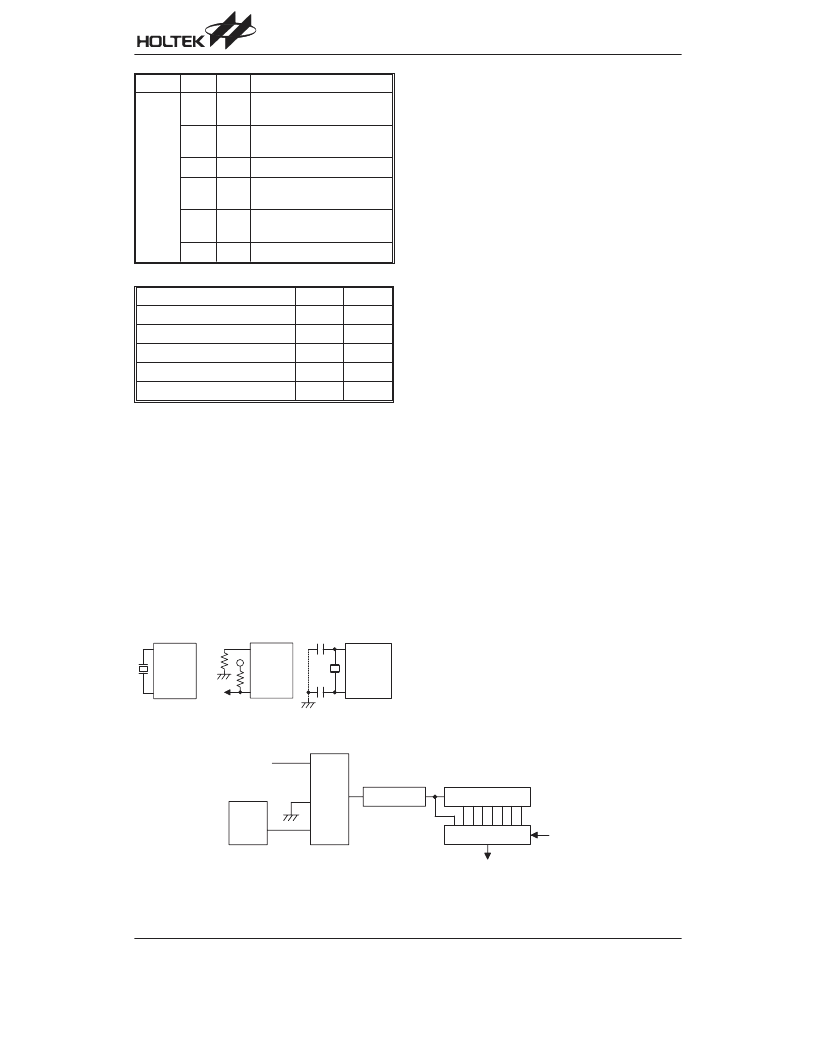- 您現(xiàn)在的位置:買(mǎi)賣(mài)IC網(wǎng) > PDF目錄385405 > HT86384 (Holtek Semiconductor Inc.) Voice Synthesizer 8-Bit MCU PDF資料下載
參數(shù)資料
| 型號(hào): | HT86384 |
| 廠(chǎng)商: | Holtek Semiconductor Inc. |
| 英文描述: | Voice Synthesizer 8-Bit MCU |
| 中文描述: | 語(yǔ)音合成器8位微控制器 |
| 文件頁(yè)數(shù): | 23/39頁(yè) |
| 文件大小: | 368K |
| 代理商: | HT86384 |
第1頁(yè)第2頁(yè)第3頁(yè)第4頁(yè)第5頁(yè)第6頁(yè)第7頁(yè)第8頁(yè)第9頁(yè)第10頁(yè)第11頁(yè)第12頁(yè)第13頁(yè)第14頁(yè)第15頁(yè)第16頁(yè)第17頁(yè)第18頁(yè)第19頁(yè)第20頁(yè)第21頁(yè)第22頁(yè)當(dāng)前第23頁(yè)第24頁(yè)第25頁(yè)第26頁(yè)第27頁(yè)第28頁(yè)第29頁(yè)第30頁(yè)第31頁(yè)第32頁(yè)第33頁(yè)第34頁(yè)第35頁(yè)第36頁(yè)第37頁(yè)第38頁(yè)第39頁(yè)

HT86XXX
Rev. 1.70
23
May 6, 2004
RegisterBit No. Label
Function
INTCH
(1EH)
0
ET2I
Controls the timer 2 interrupt
(1= enabled; 0= disabled)
1
ET3I
Controls the timer 3 interrupt
(1= enabled; 0= disabled)
2, 3
Unused bit, read as 0
4
T2F
Timer 2 interrupt request flag
(1= active; 0= inactive)
5
T3F
Timer 3 interrupt request flag
(1= active; 0= inactive)
6, 7
Unused bit, read as 0
INTC1 Register
Interrupt Source
Priority
Vector
External Interrupt
1
04H
Timer/Event Counter 0 Overflow
2
08H
Timer/Event Counter 1 Overflow
3
0CH
Timer Counter 2 Overflow
4
10H
Timer Counter 3 Overflow
5
14H
Oscillator Configuration
The HT86XXX provides two types of oscillator circuit for
the system clock, i.e., RC oscillator and crystal oscilla-
tor. No matter what type of oscillator, the signal is used
for the system clock. The HALT mode stops the system
oscillatorandignoresexternalsignaltoconservepower.
If the RC oscillator is used, an external resistor between
OSC1 and VSS is required, and the range of the resis-
tance should be from 30k
divided by 4, is available on OSC2 with pull-high resis-
tor, which can be used to synchronize external logic.
The RC oscillator provides the most cost effective solu-
tion. However, the frequency of the oscillation may vary
to 680k . The system clock,
with VDD, temperature, and the chip itself due to pro-
cess variations. It is therefore not suitable for timing
sensitive operations where accurate oscillator fre-
quency is desired.
On the other hand, if the crystal oscillator is selected, a
crystalacrossOSC1andOSC2isneededtoprovidethe
feedback and phase shift required for the oscillator, and
no other external components are required. Aresonator
may be connected between OSC1 and OSC2 to replace
the crystal and to get a frequency reference, but two ex-
ternal capacitors in OSC1 and OSC2 are required.
There is another oscillator circuit designed for Timer3 s
clock source as the RTC time base which is determined
by mask option. If the mask option determines that
Timer3 s clock source is from a 32kHz crystal, then a
32kHz crystal should be connected to XIN and XOUT.
Watchdog Timer
WDT
The WDT clock source is implemented by a dedicated
RC oscillator (WDT oscillator) or instruction clock (sys-
tem clock divided by 4), decided by mask options. This
timer is designed to prevent a software malfunction or
sequence jumping to an unknown location with unpre-
dictable results. The Watchdog Timer can be disabled
by mask option. If the Watchdog Timer is disabled, all
theexecutionsrelatedtotheWDTresultinnooperation.
Once the internal WDT oscillator (RC oscillator with pe-
riod 78 s normally) is selected, it is first divided by 256
(8-stages) to get the nominal time-out period of approxi-
mately 20 ms. This time-out period may vary with tem-
perature, VDD and process variations. By invoking the
WDT prescaler, longer time-out period can be realized.
Writing data to WS2, WS1, WS0 (bit 2,1,0 of
WDTS(09H)) can give different time-out period.
If WS2, WS1, WS0 all equal to 1, the division ratio is up
to 1:128, and the maximum time-out period is 2.6 sec-
onds.
If the device operates in a noisy environment, using the
on-chip RC oscillator (WDT OSC) is strongly recom-
mended, since the HALT will stop the system clock.
"
- '
- -
'
- -
%
&
) *
'
- -
7
. 8
System Oscillator
"
'
-
> ) *
4 9 /
'
,
'
-
1 9 /
'
4 9
9 '
,
'
9
,
2 ,
>
-
,
Watchdog Timer
相關(guān)PDF資料 |
PDF描述 |
|---|---|
| HT86576 | Voice Synthesizer 8-Bit MCU |
| HT86R192 | Voice Synthesizer 8-Bit OTP MCU |
| HT86R384 | Voice Synthesizer 8-Bit OTP MCU |
| HT86XXX | 8-Bit Voice Synthesizer MCU |
| HT8950 | Voice Modulator |
相關(guān)代理商/技術(shù)參數(shù) |
參數(shù)描述 |
|---|---|
| HT86384(68PLCC) | 制造商:未知廠(chǎng)家 制造商全稱(chēng):未知廠(chǎng)家 功能描述:Microcontroller |
| HT8650 | 制造商:未知廠(chǎng)家 制造商全稱(chēng):未知廠(chǎng)家 功能描述:IC-MESSAGE REMINDER IC |
| HT8650(28DIP) | 制造商:未知廠(chǎng)家 制造商全稱(chēng):未知廠(chǎng)家 功能描述:Speech Synthesizer |
| HT8650(28SDIP) | 制造商:未知廠(chǎng)家 制造商全稱(chēng):未知廠(chǎng)家 功能描述:Speech Synthesizer |
| HT8650(28SOIC) | 制造商:未知廠(chǎng)家 制造商全稱(chēng):未知廠(chǎng)家 功能描述:Speech Synthesizer |
發(fā)布緊急采購(gòu),3分鐘左右您將得到回復(fù)。